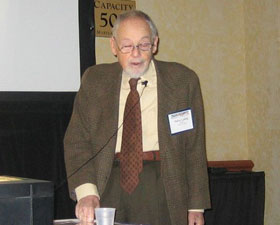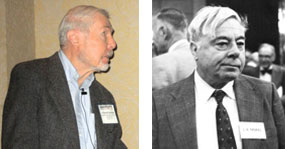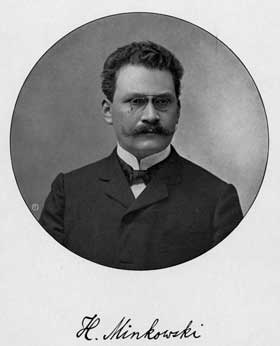Forum on the History of Physics: Contributed Papers
Report on Forum-Sponsored Session: 2010 'April' Meeting
By David C. Cassidy
Session H10: History of Physics Contributed Papers
It is not often that Leopold von Ranke, the 19th century historian of the Prussian state, appears prominently in a paper at an APS meeting. But so it was in Harry Lustig's personal account at his announced end of a 15-year excursion into the history of physics, titled "What I Have Learned in Reading and Writing History of Physics." What he has learned began with von Ranke's pioneering insistence on the use of primary documents as the foundation for recreating history "as it actually was." Although it is sometimes admissible to speculate about the past on the basis of the evidence, it is not admissible to tailor an interpretation to a preconceived thesis. Lustig's case in point, which he has closely studied during the past 15 years, is the intense controversy over Heisenberg and German fission research during World War II. While deploring the angry denunciations or heroic depictions of Heisenberg in some accounts, Lustig called for the release of additional documents pertaining to this case that are still withheld by American and British authorities. The audience celebrated Prof. Lustig's historical excursion with a standing ovation.

Photo courtesy of George Zimmerman
Harry Lustig.

photo courtesy of Emilio Segrè Visual Archive, Segrè Collection.
J. D. Jackson (left), photo courtesy of George Zimmerman. Llewellyn Thomas (right).

Photo courtesy of George Zimmerman.
Charles W. Clark.

Photo courtesy of Emilio Segrè Visual Archive, Born Collection.
Herman Minkowski, 1915.
Following the document trail on the other side of the war, Cameron Reed spoke on "Bullion to B-fields: The Silver Program of the Manhattan Project." Huge electromagnets were required for the operation of the "calutron" electromagnetic isotope-separators at Oak Ridge. Since copper for the wiring was in short supply, it was more expensive than silver. In 1942, the Army requisitioned 14,000 tons of silver bullion bars from the U.S. Treasury, which were industrially processed into wire and wound into huge magnet coils. In his unique account, Reed reported on his painstaking study of the many documents pertaining to all aspects of the "silver program," from requisitioning and processing to restoring the precious metal to the Treasury. In an interesting take on conservation he found that more metal was actually recovered than was requisitioned, apparently because of the intense cleaning of the metal-working facilities. He also calculated that more energy was expended in producing the uranium bomb than was released in the explosion over Hiroshima.
Continuing the uranium theme, in 1939 Niels Bohr stunned an audience at the Washington Conference on Theoretical Physics with the news that German researchers had discovered nuclear fission. It was the highlight of the series of annual conferences held at George Washington University during the years 1935 to 1947 (except for three years during the war). Paul Halpern reported on the history of these conferences in his paper "The Washington Conferences on Theoretical Physics: Bringing the Spirit of Copenhagen to Foggy Bottom." Inspired by the annual theoretical physics conferences in Copenhagen and other European locations, after he arrived at GWU in 1934 George Gamow established the annual conferences, with the support of the Carnegie Institution. As in Europe, problems in nuclear and quantum physics were high on the agenda, and Bohr 's several appearances always galvanized the meetings. The meetings ceased as the need for such thematic events declined and Gamow 's attention turned to cosmology.
Llewellyn Hilleth Thomas is best known for his discovery of Thomas precession and for his co-development of the Thomas-Fermi statistical atom, both done before he was 24 and before he received his PhD. As John David Jackson revealed in his paper "Llewellyn Hilleth Thomas: An Appraisal of an Unappreciated Polymath," during his subsequent career Thomas, who lived from 1903 to 1992, made many significant contributions across a wide range of other disciplines, including astrophysics, molecular physics, accelerator physics, computer design, software and hardware development, and defense research. Trained at Cambridge and Copenhagen, Thomas arrived at Ohio State University in 1929. He spent the war years at the Ballistic Research Laboratory, Aberdeen Proving Grounds, then joined IBM's Watson Scientific Computing Laboratory and Columbia University until his retirement years, which he spent at North Carolina State University. Jackson outlined many of Thomas's other significant but lesser known accomplishments, all of which lead to an appreciation of Thomas as a consummate physicist and applied mathematician.
Among three other biographically oriented papers, Charles W. Clark spoke on "Ettore Majorana and the Birth of Autoionization." Aside from the mystery of Majorana's disappearance in 1938, Clark, speaking for the three authors of the paper, pointed out several puzzles regarding the treatment of Majorana's work on autoionization. He was one of the first to apply quantum mechanics to the spectroscopy of many-electron atoms. In so doing he was the first to solve several outstanding problems by developing the theory of autoionization in 1931. Yet references to his work appeared only sporadically in the subsequent literature, and the development of the modern theory of autoionization occurred essentially without the benefit of his prior work.
Felix T. Smith asked the question "Did Minkowski Change His Mind about Non-Euclidean Symmetry in Special Relativity?" We have only three published documents on relativity written by Hermann Minkowski, all within 14 months before his sudden death on 12 January 1909. The first (A) is the text of a lecture he gave to mathematicians at Göttingen on 5 November 1907. He never published this lecture, although it announced that the world is "in a certain sense a four-dimensional, non-Euclidean manifold" and supported that notion by showing the geometry of relativistic velocity space to be non-Euclidean. Only six weeks later he submitted for publication a long paper (B), containing most of the results in A and much more, but leaving out any statement about its non-Euclidean geometric implications. The third paper (C) is his most famous, the lecture he presented at a scientific congress on 21 September 1908. It was devoted to the concept of four-dimensional space-time. It does not mention the non-Euclidean aspect at all. Historians have long wondered why Minkowski never published some of the most prominent conclusions of his first lecture, those dealing with non-Euclidean geometry.
Ten years ago Scott Walter discovered in A an error in sign in an equation for the velocity four-vector, but that error does not contaminate the lecture's conclusion about the non-Euclidean geometry of velocity space. Smith's analysis showed the velocity equations were incomplete in other ways as well. Thus the velocity paragraph in A seems to have been a very late and hasty insert, written at the moment Minkowski was discovering the true covariant form of the velocity vector, before he had all the details correct. But the form of the equations brought to him the sudden insight that all this was a new case of a mathematically old story, the non-Euclidean geometry of Lobachevsky and Bolyai. It appears this new insight came to Minkowski very close to the date of the lecture, and he thought it so important that he added it to his text even though it was not complete. With this understanding, the more mature earlier text of the lecture can now be separated from the less ripened inserted material, and the latter examined on its own. Doing so sheds much light on Minkowski's creative process—the rough guess at what he thinks the form of the result should be, testing it against his other expectations, new adjustments, while learning from the process. In his mathematical work, Minkowski was well known for his powerful geometric insight and imagination; it is now possible to see how he brought this to bear on the velocity problem, and how it helped bring him to his non-Euclidean insight. Minkowski probably wanted to explore the topic further before publishing it. Arnold Sommerfeld published paper A six years after Minkowski's untimely death. The answer to Smith's original question is "No:" Minkowski did not change his mind.
In "Twist ‘Til We Tear the House Down: How Clifford Solved the Universe in 1870," James Beichler argues that British mathematician W. K. Clifford had introduced a curved hyperspace theory into physics in 1870, long before similar theories of the early 20th century. Clifford and his followers developed their curved-space theory for electromagnetism, which is one reason it has been overlooked by most historians. Yet because Clifford argued for the reality of space curvature in electromagnetism, he facilitated the acceptance of Einstein's curved space-time for gravitation, and he may be regarded as a precursor of modern unification theories. His theory of "matter as curved space" influenced Cartan's spinor theory and Penrose's twistor theory.
In one of two concluding papers, Clarence A. Gall presented a historical view of the development of Gustav Kirchhoff's black-body radiation distribution functions. Kirchhoff introduced a new function based on emission as a decay process that fits the Stefan-Boltzmann and Wien displacement laws exactly. It contradicts the traditional assumption that a hotter body always emits more intensely than a colder body for all wavelengths, which is supported by observational infrared astronomy. Finally, Jeffrey Boyd described the ancient emission and intromission theories of sight, and presented a speculative hybrid theory developed in 1996.
Note Added: This article represents the views of the author, which are not necessarily those of the FHP or APS.
